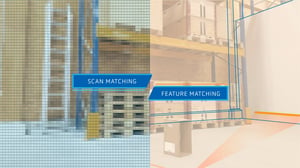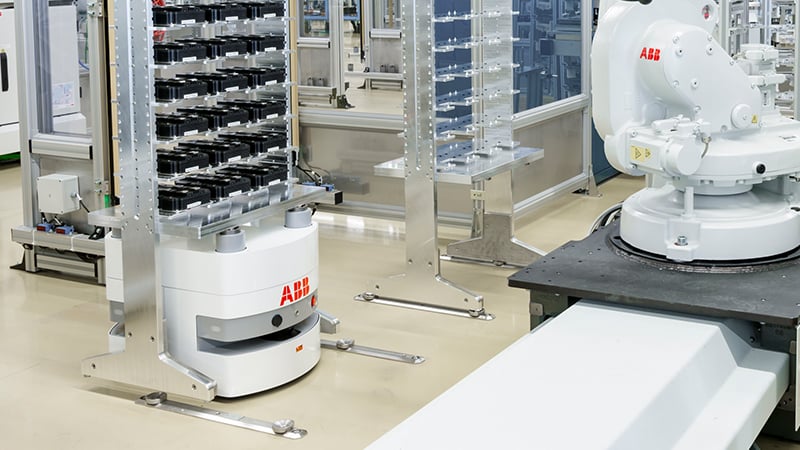1. How is the robot installed and its operations modified?
Will commissioning a particular mobile robot take hours, days, or weeks? Who will carry out this work? And how might it disrupt your normal operations?
The main thing that determines installation times is the navigation technology used by the robot. Since most AMRs use natural navigation, such as ANT, they are quick and cost-efficient to install with only minimal infrastructure changes required (just adding a few reflective stickers if natural features are lacking).
Outside of initial commissioning, also think further ahead, into the future. Since modern sites regularly evolve, there is a good chance you will want to change the missions your robots perform at some point. Who will handle this reconfiguration work and how?
Will these hours be included in your regular maintenance plan, or will they require an additional paid project by your integrator that you need to budget in? It helps to be clear on such points in advance, to avoid unplanned expenses.
2. How easily can you build out a full AMR fleet?
As your operation evolves and your AMRs start to pay their way, you might want to grow your fleet of robots. Ask how new robots can be added to the existing fleet – is this straightforward or complicated and time-consuming? How is traffic handled, for example at intersections – do you need to program behaviors or is it automatic (and how well does it work)? How are jobs allocated to different robots?
Last but not least, does an AMR’s fleet management system lock your business into only that brand of vehicle? Or can it be used to manage different brands of mobile robots and even AGVs (as is the case with ANT)?
Multi-brand capabilities will vastly expand your fleet-building options while mitigating the risk of being reliant on a single vehicle supplier.
3. How does the robot’s safety system work?
If your autonomous mobile robots will operate around human staff, you want to be sure they do not represent a safety risk. So, learn how their safety systems work.
AMRs running on natural navigation typically have LiDAR-based safety laser scanners installed. These detect any objects that enter a robot’s ‘safety field’ (a pre-defined area around the vehicle) and then either take an alternative route or slow to a stop. What height are these sensors? Are they at both the front and back of the robot? What are the optimal safety field settings for your site?
Do the robots you are considering comply with domestic and international safety regulations such as EN 1525 (“Safety of Industrial Trucks, Driverless Trucks and Their Systems) and ANSI 56.5:2012 (“Safety Standard for Driverless, Automatic Guided Industrial Vehicles and Automated Functions of Manned Industrial Vehicles”)?
You need to know all this information, not only as part of your due diligence but in order to train other staff about how the robots work before they are deployed.
4. What kind of maintenance and support plans are offered?
Autonomous mobile robots driven by natural navigation offer reliable, repeatable accuracy. But only if they are maintained correctly. Make sure a solid hardware maintenance plan is available before you buy.
Carefully check what this maintenance plan includes, as maintenance of your robot hardware is only one piece of the puzzle. You should also ask about making modifications to your AMR’s software project. If you want to alter a robot’s routes and actions, will your AMR integrator handle that? And will this reconfiguration be included in your plan?
Expect to pay approximately 10% of a robot’s sticker price, per year, for maintenance.
5. How many systems are in commercial operation?
If you are planning to invest thousands, or even hundreds of thousands, of dollars in an AMR solution, you want to be sure the system you are purchasing is proven in the real world. In other words, are hundreds of organizations already using this AMR, or will you be one of the first to install it?
Be sure to dig into these numbers with the supplier. And, if possible, try to speak with existing customers in a non-competing industry to hear about their experiences first-hand. There are AMR suppliers on the market with a reputation for performing stunning on-site demos, but which, after the sale, struggle to get commercial operations performing correctly. Avoid becoming one of these cautionary tales.
6. Ensure your processes are automation-ready
A human-based manual process cannot always be automated simply ‘as is’. There is often some adaptation required. Therefore, it is important to analyze, simplify and standardize your mobile transportation processes before slotting AMRs into place.
Bear in mind, mobile robots can only do as they are programmed. They cannot yet improvise on the fly like human operators can (except for avoiding obstacles). By standardizing jobs in advance, you won’t be asking them to.



